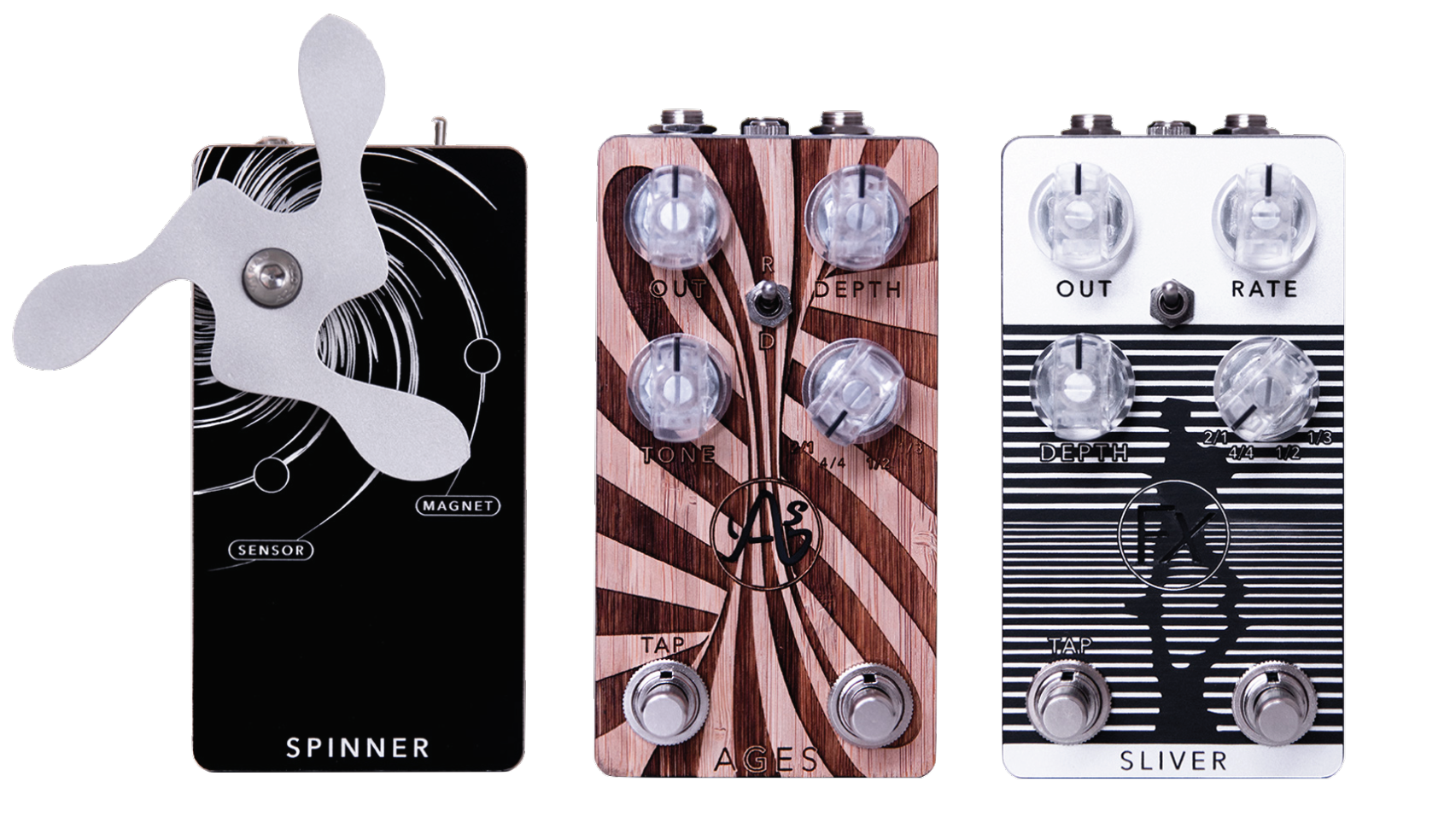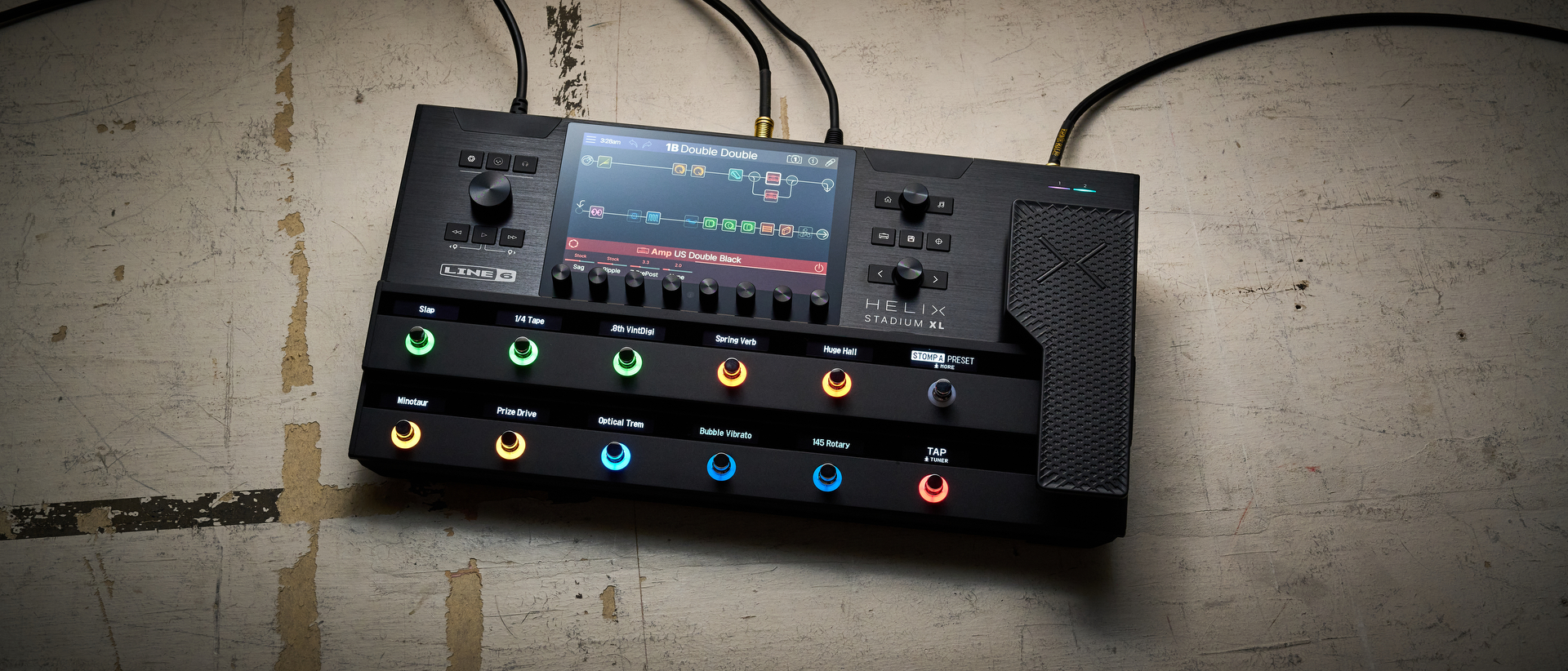Guitar World Verdict
Anasounds’ two unique takes on two very different types of tremolo effect seem enticing enough, and that’s before you add the never-before-heard capabilities of the Spinner expression pedal, which does things that other expression pedals literally cannot do.
Pros
- +
Unique design.
- +
Very interactive.
- +
High quality sounds.
Cons
- -
Stereo would be nice.
You can trust Guitar World
You only need to look at any pedal by France’s Anasounds to know you’re in for something a little different. Their designs feature elegant laser-cut wooden faces, cool see‑through knobs, plexiglas panels, logos that light up in sync with rate controls or, in the case of the Spinner expression pedal, what looks like a freaking fidget spinner protruding from the top! Everything they do has an aura of ‘unique’ about it. Distributor sent us three Anasounds pedals to check out: two tremolo pedals (the Ages Harmonic Tremolo and the Sliver Tremolo) and the Spinner.
The Ages Harmonic Tremolo is Anasounds’ take on a sound that you might know under one of a number of names: Univibe, harmonic vibrato, vibe… You know, that syrupy, undulating tone recognisable in the recordings of artists like Jimi Hendrix and Pink Floyd. It’s more like a phaser swimming through honey rather than the ‘rhythmic volume variations’ effect with think of when we hear the word ‘tremolo pedal.’
The Ages has four knobs (output volume, tone, depth and rhythm subdivision) along with a Tap Tempo footswitch for easily setting your effect speed. The inclusion of a tone control is a neat idea that you don’t often find on pedals of this type. Even more rare is the Attack Detector mini toggle, which allows you to change the depth or rate of the tremolo effect in realtime through the strength of your pick attack. The Subdivision knob offers four settings: the first doubles the preset tempo; the second is whatever tap tempo value you’ve input. The third position divides the tempo by two, and the final setting divides the tempo by three.
The Sliver Tremolo is a more straightforward ‘variations in volume level’ tremolo effect, although Anasounds doesn’t release a pedal without bringing something unique to the table. In Sliver’s case, a purely analog signal path is modulated by a digital processor: the processor doesn’t touch your guitar signal at all but it generates waveforms that are transmitted to the optical circuit to apply the tremolo effect.
The analog and digital PBCs are carefully separated inside the circuit, partially to make servicing easier but also so you can swap out new chips with additional waveforms in the future. How ‘bout that!
The digital processor also allows the Sliver to incorporate a tap-tempo footswitch which can also double as a self-oscillation trigger when you hold it down. The control knobs govern output, rate, depth and rhythmic subdivision (with the same parameters as the Ages’ subdivision pot). There’s also a mini-toggle for selecting waveform (saw, sine, square), and trimpots for adjusting the bias and output level.
Each of these pedals has a little eighth-inch TRS jack for use with the Spinner expression pedal. There’s nothing else out there like the Spinner: its top-mounted spinny-thing (Anasounds often refers to it as a star) incorporates three magnets which interact with a sensor: literally spin it with your hand or the side of your foot and the rotation rate will be sent to whichever pedal you’re plugged into. Give it a hearty thwack and the effect will immediately speed up to the tempo of the spin, gradually slowing until it returns to your preset tempo.
All the latest guitar news, interviews, lessons, reviews, deals and more, direct to your inbox!
Inside are three trimpots to set the speed thresholds that activate and deactivate the effect, and the acceleration or deceleration of the effect. A mini-toggle lets you trigger your effect while the star is spinning even if the effect is turned off. There’s also a killswitch mode for otherwise unattainable stutter effects.
That’s a lot to take in, but any perceived complicated-ness melts away once you start to play. The Ages sounds like a great Univibe-style effect, but that’s only the beginning of it: once you start messing around with the Attack Detector switch you open up a whole new world of interactivity. The harmonic vibrato effect is no longer something that’s ‘happening to’ your guitar sound. It becomes a part of whatever you’re playing. Hit the string harder to speed up the speed of the effect for a really dramatic accent, or trigger deeper effect levels for emphasis. Add the Spinner for sounds that were literally unavailable until now.
The Sliver Tremolo is also a really nice-sounding version of a traditional effect, but again really steps up a notch when you bring in the capabilities of the Spinner. It’s capable of producing a truly beautifully expressive shimmer effect that interacts with your music.
Imagine hitting a sustaining chord as the rest of the band stops at the end of a section and sending your tremolo into a rapid, fluttery flurry that gradually backs off until either returning to the original tempo or until the effect turns off completely, and then having the rest of the band kick back in again.
Anasounds didn’t even need to create the Spinner in order to great sounds and performance features out of its pedals – they certainly stand on their own merits without it – but the Spinner brings out so many cool new possibilities that it could do what the DigiTech Whammy Pedal did upon its introduction, which is to inspire players to find their own ways to use it.
Once you get the hang of it, manipulating the spinning star becomes as personal and unique as the way each player manipulates their guitar strings. So yeah, by all means give Anasounds’ tremolo pedals serious consideration – both are well-built and feature‑packed – and then make sure you budget for a Spinner as well to bring out something really unique.
Peter Hodgson is a journalist, an award-winning shredder, an instructional columnist, a guitar teacher, a guitar repair guy, a dad and an extremely amateur barista. He runs a blog, I Heart Guitar, which allows him to publicly geek out over his obsessions. Peter is from Melbourne, Australia, where he writes for various magazines, including Guitar World.

